Test geek and founder of Aptitude-Test-Prep.com
What Is the Amberjack Assessment?
The Amberjack Assessment is a blended assessment that combines behavioral, situational judgment and cognitive items to assess a candidate’s potential job success. That structure is motivated by Amberjack’s vision of measuring pure potential rather than past experience or privilege.
As such, this assessment is predominantly used in early talent positions – graduates, apprenticeships, and placements. Leading employers using the Amberjack Assessment are AtkinsRéalis, Morrisons, BDO, Allen & Overy, and more.
Test Structure and Question Format
While Amberjack modifies its assessment to suit the particular employer, at its core, the assessment follows a rather standard format:
- 22 multiple-choice/ranking questions
- 3 interview questions (written/video)
- Situational judgment questions follow a Most-Least format.
- Cognitive questions simulate an email from a colleague.
Below we cover the basic characteristics of each question type.
In the Free Practice section, you can see some examples with explanations and recommendations for success. You may also check the Test Interface section for more details on how the assessment works.
Situational Judgment Questions
These questions constitute the majority of the Amberjack test, and include a brief scenario followed by 4 optional responses.
You will need to rank the most and least recommended responses.
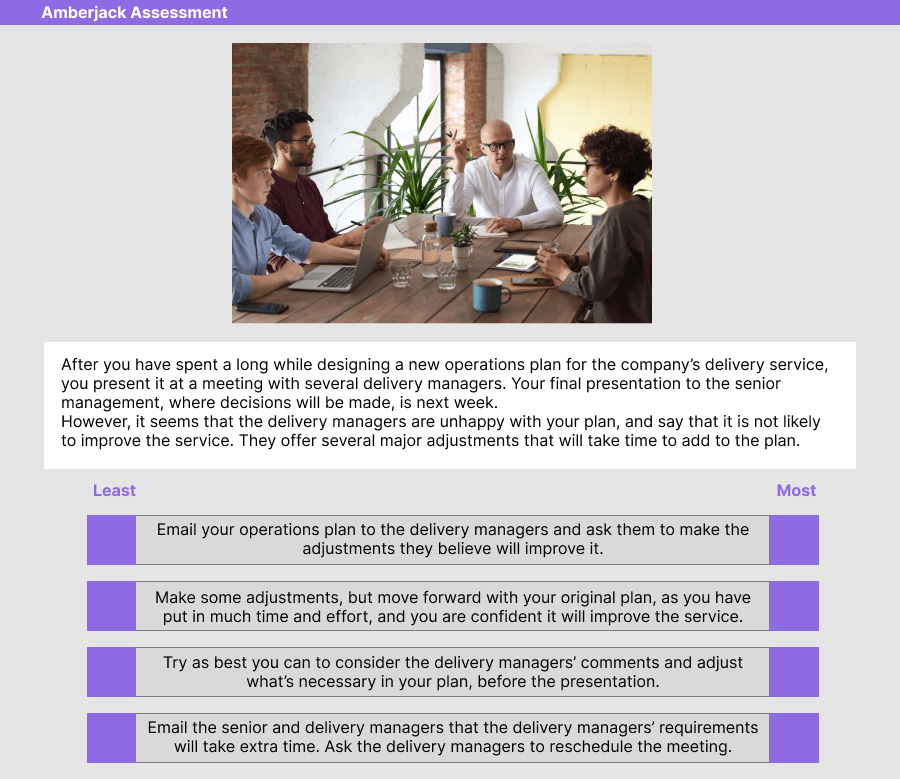
Pro Tip
Some of the situational judgment questions will assess 2 pillars simultaneously and will therefore be trickier.
Numerical Questions
This type of question will be structured as an email from a colleague, including one or more numerical data sources – graphs and tables. Your fictitious colleague will ask you a question based on the information, and you will be required to choose the correct response out of 4 possible answers.

Pro Tip
The numerical questions are characterized by information overload – see more in the Tips section.
Verbal Questions
The Verbal questions are similar to the numerical ones in structure and format, but you will be requested to respond to a question regarding a short piece of text. You will need to choose the correct response out of 3 options.
While these questions are complex, you should be careful not to rely on any information other than the text.

Pro Tip
If you are looking for prep materials for the Amberjack Assessment, we recommend JobTestPrep’s Prep Course. The material is tailored mostly for BDO candidates, but will provide solid preparation for the Amberjack Assessment for other employers as well.
Full Disclosure: We are affiliated with JobTestPrep. Clicking the links helps us to keep providing you with high-quality, ad-free content.
Video Interview
The last part of the Amberjack Assessment consists of several video questions.
- You will be allowed to prepare your response for as long as you want.
- You will have 2 minutes to record your response.
- You will have only one shot to record your response. Once you start recording, you will not be able to pause or restart.
Pro Tip
The video questions will function as a standard interview, but will not be reviewed by your employer, rather by an Amberjack assessor. The assessor will review your responses specifically based on the 4 pillars measured by the assessment (see below, as well as the Tips section).
What Does the Amberjack Assessment Measure?
The Amberjack Assessment is designed to measure candidates’ potential of success in the job they applied for. To do so, the test assesses 4 key pillars, divided into 11 sub-categories.
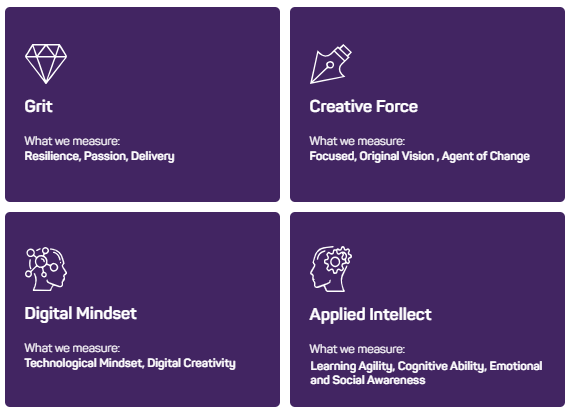
Source
Here are the 4 pillars of the Amberjack Assessment:
Grit
Grit is a person’s ability to keep pursuing goals in the face of challenge, to adapt to changes and improve.
This pillar is divided into 3 sub-categories:
- Resilience
- Passion (Drive)
- Delivery (Agility)
Creative Force
Creative Force means the confidence and ability to test and implement new approaches and ways of thinking. It is a future-oriented mindset that focuses on positive change of self and others.
The 3 traits measured in this pillar are:
- Focus
- Original Vision
- Agent of Change
Applied Intellect
A high Applied Intellect indicates the ability to apply one’s intelligence and knowledge to a variety of situations and generate innovative solutions to problems. While traditional assessments measure only cognitive ability, in the Amberjack Assessment it is only one of 3 components:
- Cognitive Ability
- Social and Emotional Intelligence
- Learning Agility
Digital Mindset
Digital Mindset is the natural proclivity to use technological solutions – not necessarily practical technological knowledge, but the openness to new technology and the abilities to conceptualize, adapt, and utilize it. Two traits are included in this pillar:
- Technological Mindset
- Digital Creativity
What Employers Use the Amberjack Assessment?
Amberjack is particularly popular among UK employers hiring for early careers. Some major employers using the assessment in their hiring process are:
Test Invitation
If you have been to take an Amberjack test, you will receive a test invitation via email directly from your employer.
The invitation will not always include the name Amberjack, but if it includes or links to either of the following names, it means you will be taking the Amberjack assessment:
- Amberjack
- Weareamberjack
- Ambertrack
Here is, for instance, the Amberjack test invitation sent to candidates by Atkins:

Test Interface
The interface of the Amberjack assessment is modern, interactive, and rather easy to follow. A 5-minutes video in the beginning of the assessment will provide you with all you need to know.
However, here are some important things to know in advance:
- The test is untimed, but time will have an effect on your score, particularly in the cognitive ability questions.
- You are allowed to use a calculator and scratch paper.
- You will need a webcam and a microphone for the video interview section.
- Cognitive and situational judgment questions are mixed through the assessment.
- You must answer all questions.
- You cannot go back to submitted questions.
Pro Tip
While Amberjack tailors its content to match that of the specific employer, the test structure, subject matter, and measured traits, are rather similar across the board. As such, JobTestPrep’s Amberjack Prep for BDO is a good prep option for any Amberjack assessment.
Free Amberjack Assessment Practice
This free Amberjack sample practice test is designed to get you familiar with:
- Types of questions
- Measured pillars (traits)
- Level of difficulty
The test contains 6 questions and is untimed.
Good luck!
Question 1
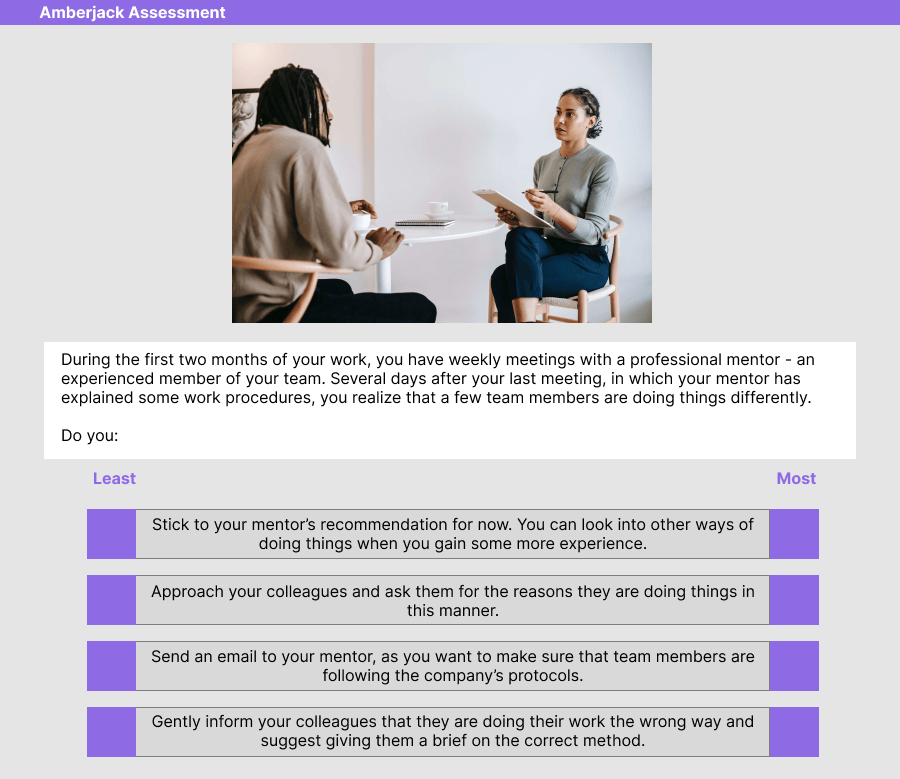
Recommended Answer
Most: B
Least: D
This question aims to measure the Creative Force pillar. The core of the question revolves around your approach to innovation and change.
Let’s review each response:
Answer A – Stick to your mentor’s recommendation for now. You can look into other ways of doing things when you gain some more experience.
This response lacks some flexibility and self-confidence. The way you approach problems should not depend on your experience, rather the objective details of the case. Being open to learning and adapting to new methods is always desirable, even if you lack experience. Remember that the very aim of the Amberjack Assessment is to eliminate the effect of past experience and knowledge.
Answer B – Approach your colleagues and ask them for the reasons they are doing things in this manner.
This is the most recommended response. It demonstrates openness to change and a healthy approach to innovation. By asking for your colleagues’ feedback, you will be able to better understand what solutions and methods are best for each scenario, what will allow you, as you gain more experience, to make such informed decisions on your own.
Answer C – Send an email to your mentor, as you want to make sure that team members are following the company’s protocols.
This response is rather similar in essence to answer A. It shows that you rely mostly on authority as your guide to decision making, rather than on the specific, relevant case at hand. However, this response is not as bad as response D, as it at least demonstrates modesty and willingness to self-doubt.
Answer D – Gently inform your colleagues that they are doing their work the wrong way and suggest giving them a brief on the correct method.
This is the least recommended response. It demonstrates a rigid mindset that lacks openness to new ideas and approaches. This mindset eventually results in a behavior that may be considered arrogant, as you determine your colleagues’ actions as incorrect in advance, before allowing them to comment.
Question 2
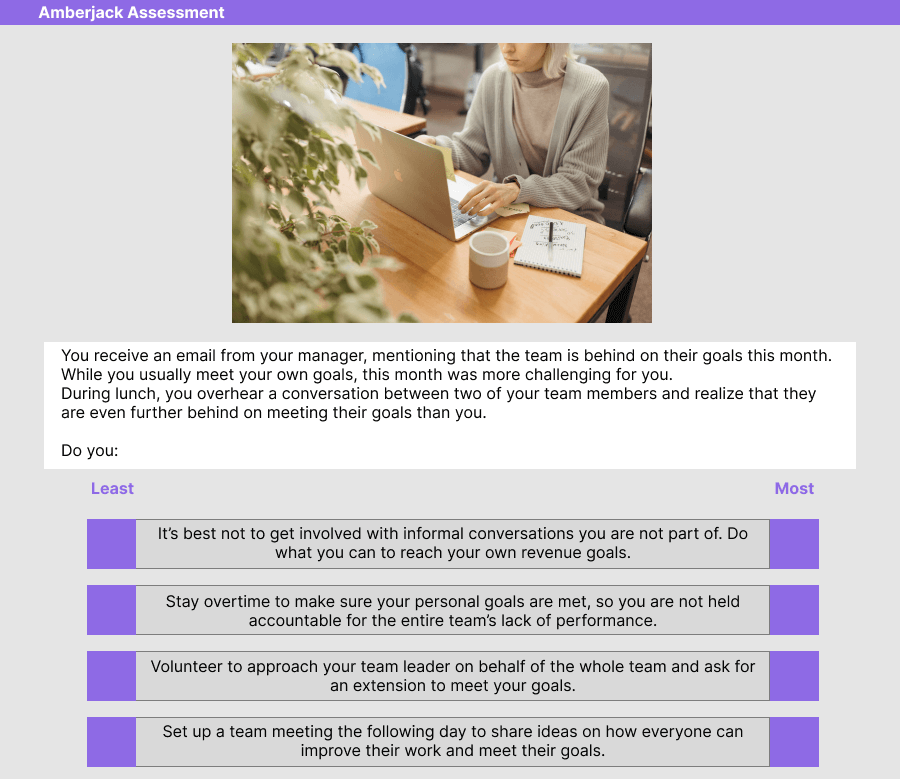
Recommended Answer
Most: D
Least: A
This question measures two pillars: Grit and Applied Intellect. The core of the question is twofold:
- How motivated and committed are you to achieve your goals in the face of setbacks (Grit).
- How you socially and emotionally operate within a team (Applied Intellect).
A table will help exemplify this:
| Response |
Grit |
Social and Emotional Intelligence |
| A (Least) |
Low |
Low |
| B |
High |
Low |
| C |
Low |
High |
| D (Most) |
High |
High |
Let’s review each response:
Answer A – It’s best not to get involved with informal conversations you are not part of. Do what you can to reach your own revenue goals.
This is the least recommended response as it is low on both social intelligence and grit. “Doing what you can” demonstrates a somewhat passive approach that is set on maintaining roughly the same effort and methods of work that have been taken thus far. Additionally, by ignoring your teammates’ situation, you are taking a passive approach in that sense as well.
Answer B – Stay overtime to make sure your personal goals are met, so you are not held accountable for the entire team’s lack of performance.
This response demonstrates high levels of grit. However, by being selfish and taking care of yourself alone, it shows low social and emotional intelligence.
Answer C – Volunteer to approach your team leader on behalf of the whole team and ask for an extension to meet your goals.
This response is opposite to response C. It demonstrates care for your team and high social and emotional intelligence, but completely lacks grit. By requesting to extend the time to meet your goals you are not tackling the problem, rather attempting to avert it.
Answer D – Set up a team meeting the following day to share ideas on how everyone can improve their work and meet their goals.
This is the most recommended response. It demonstrates both grit – motivation to take the initiative and overcome a challenge, AND social intelligence, by keeping everyone involved and helping the team rather than yourself.
Question 3

Answer and Explanation
The correct answer is 2.
To find the IceBerg’s revenue as a percentage of all three brands, we will:
- Sum up the monthly revenue of each brand.
- Sum up the total revenue of all three brands.
- Find the percentage of each brand of this total.
Results are shown in the table below:
| Month |
Fortescue |
IceBerg |
Munchkin |
| Jan |
140 |
90 |
50 |
| Feb |
210 |
100 |
120 |
| ar |
130 |
50 |
110 |
| Apr |
200 |
70 |
130 |
| May |
150 |
110 |
220 |
| Jun |
170 |
30 |
100 |
| Jul |
200 |
20 |
90 |
| Aug |
160 |
20 |
80 |
| Sep |
90 |
60 |
80 |
| Oct |
110 |
80 |
60 |
| Nov |
80 |
120 |
70 |
| Dec |
70 |
100 |
50 |
| Total |
1,710 |
850 |
1,160 |
IceBerg’s revenue (850) accounts for approximately 22.8% of the total revenue of all three brands (1,710 + 850 + 1,160).
Question 4

Answer and Explanation
The correct answer is 1.
While this question contains a lot of information, most of it is irrelevant. What interests us is the overall cost of each training program.
That can be calculated as follows:
Overall Cost = 125 x [Cost per Employee] x [1 – Discount] + [Registration Fee]
Results are shown in the table below:
| Program |
Cost for Employees |
Registration Fee |
Total |
| Storytelling |
125 x $170 = $17,000 |
$5,000 |
$22,000 |
| UX/UI |
125 x $200 = $21,250 |
$2,500 |
$23,750 |
| A/B Testing |
125x $185 = $23,125 |
$2,500 |
$25,625 |
So, Storytelling training is the cheapest option at $22,000.
Question 5
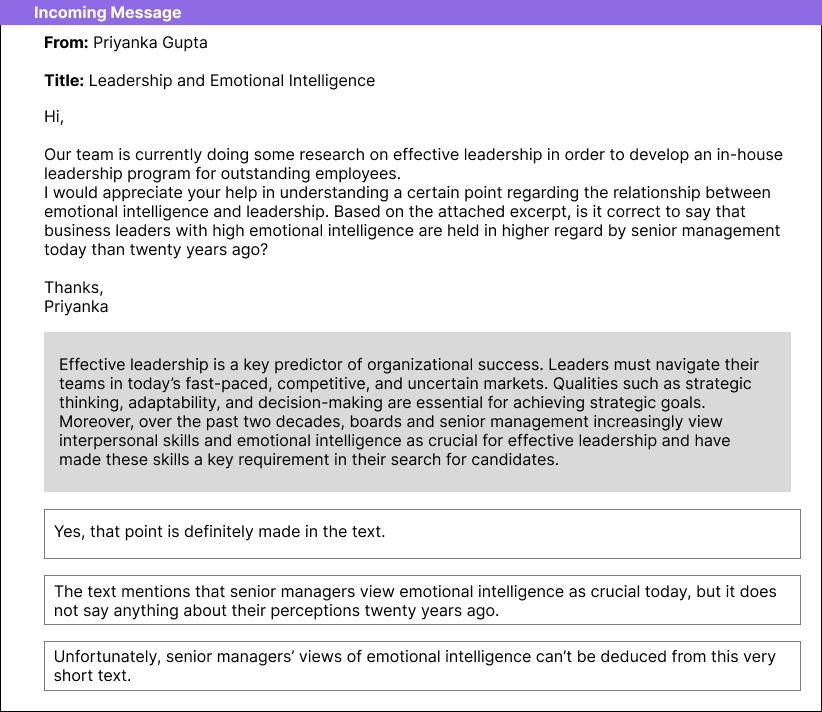
Answer and Explanation
The correct answer is 1.
According to the text:
“Over the past two decades…senior management increasingly view…emotional intelligence as crucial for effective leadership and have made these skills a key requirement in their search for candidates.”
The word “increasingly” indicates that senior management view emotional intelligence as more crucial for effective leadership than twenty years ago.
Question 6

Answer and Explanation
The correct answer is 3.
According to the text: “…transformations also require the commitment and involvement of the entire organization to prevail – managers and employees alike.
Hence, a digital transformation imposed by senior management will likely be unsuccessful, according to the text. Similarly, a transformation which leaves senior management behind (as in answer 4) is also likely to fail.
4 Expert Tips for the Amberjack Assessment
Considering all the unique features of the Amberjack Assessment, here are 4 tips for acing it:
Tip #1 – In the Numerical Questions, Take a Look at the Answers First
The numerical questions in the Amberjack Assessment are characterized by an information overload. While this may be confusing, looking at the possible answers before approaching the actual question might significantly simplify the solution.
For instance, you may be given the financial data for a whole year and be asked to find the find the most profitable month. By checking only the answer options, you can calculate only 4 months rather than 12.
Note that this will not always be the case, and you will occasionally be required to conduct rather long calculations.
Tip #2 – In the Verbal Questions, Focus on Encapsulating Main Ideas
The verbal questions on the Amberjack Assessment will mostly assess your inferential comprehension – namely, extract nuances of various places in the text to infer a main, complex idea presented in the text. They will not aim to measure your vocabulary, grammar, or understanding of specific elements of the text.
Here are some examples:
- According to the text, what is the main benefit of X over Y?
- According to the text, in what cases should one use X?
- How would you describe the text’s definition of X?
Tip #3 – In SJT Questions, Always Consider the 4 Pillars
In the Test Overview section, we have covered the 4 pillars assessed by Amberjack – Grit, Creative Force, Applied Intellect, and Digital Mindset. Whenever you approach a situational judgment question, consider:
- What pillar is being assessed?
- What responses are most and least aligned with this pillar?
Tip #4 – Practice for the Interview Section
Your responses to the video questions will be reviewed by a human assessor, as is mentioned on Amberjack’s manual. The assessor will evaluate your responses against the behavioral traits measured in the assessment.
Therefore, it is important to prepare some experiences, thoughts and behaviors that reflect these traits. Here are some examples for questions you may be asked, and their respective measured traits. JobTestPrep offers an optional video interview guide for their Amberjack Prep, so that may be a good place to gain some insights.
Grit
- What challenges do you expect to encounter on the job, and how do you plan to overcome them?
- What would you consider as success in your career?
Creative Force
- How do you see your future in the company and in the industry in general?
- Describe an incident in which you have applied a new solution to a problem you have faced.
Applied Intellect
- What are the personal strengths and skills do you believe will be most influential for your ability to succeed in this role?
- How will this role help you to develop personally and professionally?
Digital Mindset
- What new technologies and tools do you believe will have the most impact on the future of the industry?
- How do you approach the need to integrate new technologies in your work?














